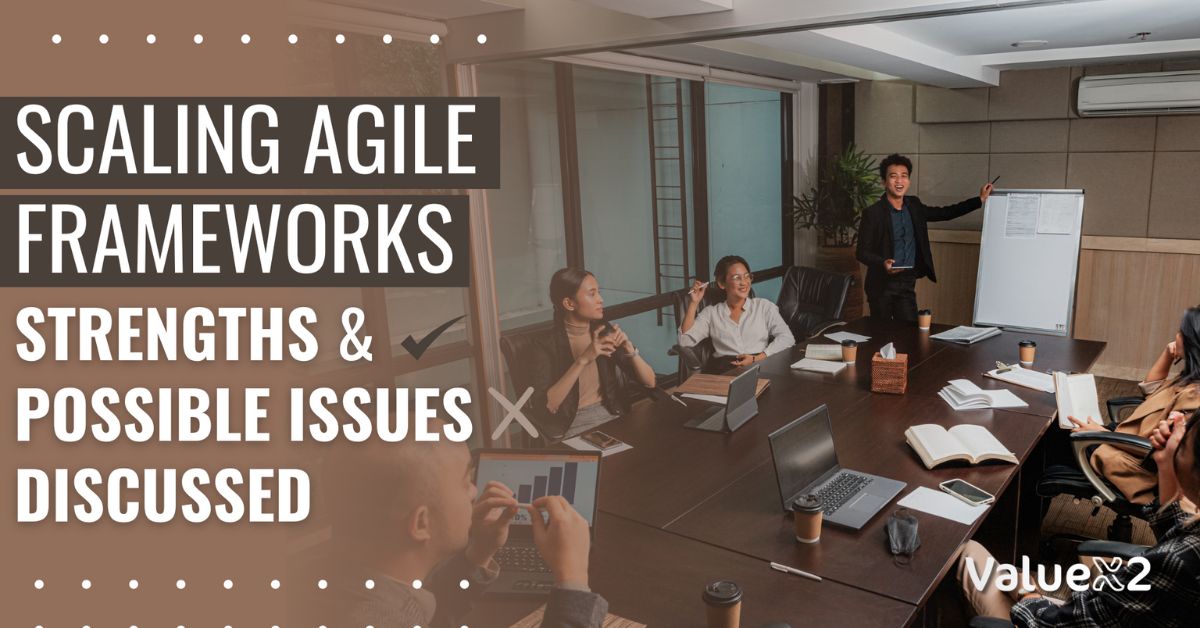When it comes to scaling Agile, you need to know how each framework operates, its advantages, and potential drawbacks. This comes in handy when selecting the best framework for your company.
What should you consider when Scaling Agile Frameworks?
Agile frameworks have proven to be the best in the current vastly growing business environment. It is considered fantastic for organizations with small teams, but as the organization begins the journey of growth and transformation, it encounters new problems and challenges. The framework you choose is not 100% perfect, which is why you need to take time and understand the strengths and weaknesses that could arise using SAFe, LeSS, DA or any other framework. Let’s break it down!
Why Explore the Strengths and Issues of Agile Scaling Frameworks?
If you want to come up with informed decisions in your organization, understand the Strengths and possible challenges. Learn how different scaled agile frameworks compare, and identify one that aligns with your organization’s unique context. Every Scaling Framework has a unique set of attributes; these attributes are what will determine the right framework for every scenario. So, being aware of the possible challenges gives you an upper hand in addressing them proactively.
Key Strengths of Scaling Agile Frameworks
Scaling Agile Frameworks offer you and your organization numerous advantages. You need to take full custody of them and implement them properly for you to reap the maximum benefits. Here are the benefits of Scaling Agile Frameworks:
- Enhanced Inter-team Coordination: Structured methods provided by frameworks like SAFe and Scrum@Scale improve inter-team coordination and communication.
- Enhanced Productivity: Simplifying procedures, cutting down on duplication, and enabling improved resource management are all possible outcomes of scaling frameworks.
- Increased Flexibility: Organizations can customize techniques to fit particular needs by using frameworks like Disciplined Agile (DA), which offer flexibility.
- Improved Risk Management: These frameworks assist teams in identifying and mitigating risks at an early stage by segmenting projects into smaller, more manageable chunks.
Possible Issues that could arise when Scaling Agile
Despite the benefits, we have gathered possible challenges that may be accompanied by these Scaling Agile Frameworks. Here, let’s have a look:
- Complexity: Although comprehensive, frameworks such as SAFe can become excessively complex, especially for smaller teams or individuals who are not familiar with agile processes. This intricacy may cause misunderstandings and ineffectiveness.
- Resistance to Change: Trying a new framework often involves a cultural shift. This is not bad, but it affects teams that are built on a certain way of working.
- Coordination Challenges: Organizations with frameworks that don’t fit their structure, witness difficulty in communication and misalignment as the number of teams increases.
- Overhead Costs: Certain frameworks can add more overhead in terms of time, training, and resources, especially ones like SAFe which have intricate roles and processes.
How Do the Major Scaling Frameworks Compare?
Here is a brief comparison of various well-liked frameworks’ advantages and possible disadvantages:
| Framework | Strengths | Potential Issues |
| SAFe | Highly structured, good for large enterprises | Can be overly complex and resource-intensive |
| LeSS | Simple, stays true to Scrum principles | May not provide enough support for complex needs |
| Disciplined Agile (DA) | Flexible, customizable to organizational needs | Requires deep understanding of Agile principles |
| Scrum@Scale | Scalable while maintaining Scrum practices | May lack structure for highly complex products |
| Nexus | Good for managing dependencies between teams | Can struggle with very large or complex projects |
Which Framework Aligns Best with Your Needs?
Choosing the best-fit framework is not just about picking the most popular option, it involves finding a framework that fits with your organization’s size, culture and goals. Here are some examples:
- Large Enterprises: SAFe comes out on top, as it is the best option for large organizations as it offers a comprehensive structure.
- Medium-sized Organizations: Do you value simplicity? Does your organization adhere to scrum? If you align with these traits, Large Scale Scrum (LeSS) is your go-to.
- Diverse Needs: Disciplined Agile gives you the freedom to customize your strategy.
- Scrum-driven Businesses: For those seeking to scale current Scrum techniques without needless complication, Scrum@Scale or Nexus may be ideal.
To complement your decision-making with validated data, the external report “State of Agile Culture Report” provides unique global insights into agile adoption patterns and cultural indicators across scaling environments.
ValueX2 Trainings
For you to master the strengths and overcome the challenges of these frameworks, you are required to acquire in-depth knowledge and valuable experience in Scaling Agile Frameworks. At ValueX2, we offer you specialized training programs that are designed to fit your needs and help you bring the necessary impact to your organization. Our trainers are well-equipped and ready to take you through our programs. They are experienced, serving over 10 years in this field, to equip you with the necessary skills and knowledge to prosper as an Agilist at an affordable price.
Whether you are new to Agile, an expert or just looking to scale up, we have courses for everyone globally. Our Agile certifications are globally recognized and accepted, hence you can take a course with us from anywhere in the world. Check out our upcoming training sessions here!
FAQs
Q: What is the most flexible Scaling Agile Framework?
A: The most flexible framework is Disciplined Agile (DA). It is known for its flexibility, enabling firms and enterprises to tailor practices according to their unique needs and challenges.
Q: What are Scaling Agile Frameworks?
A: Agile methodologies are great, especially for small teams; however, large organizations struggle to implement them effectively. This is where Agile Scaling Frameworks come in. These are frameworks that provide a structured approach to applying Agile principles at an enterprise level. It builds a bridge between Agile flexibility and the complexity of organizational needs.
Q: What is the main issue when Agile is scaling to large systems?
A: When you have a lot of teams working on the same thing, it tends to get messy. Scaling Agile Frameworks helps avoid this by giving clear roles, plans and channels to communicate from. ‘
Q: What are the common challenges when Scaling Agile?
A: The common challenges that may occur include:
- Increased complexity
- Resistance to change
- Coordination difficulties
- Overhead in applying new roles and processes.
Q: Can small teams benefit from scaling frameworks?
A: Definitely. However, you will need to choose the framework that aligns with your team size and experience in Scrum and Agile. For small teams, frameworks like the LeSS are effective.
Q: What are the benefits of the Scaled Agile Framework (SAFe)?
A: One well-liked scaling framework that can assist big businesses is SAFe. Here are some of its benefits:
- Complete tasks more quickly (just picture reduced wait times for that new function!).
- Boost the calibre of their output (e.g., by reducing software flaws).
- Increase employee satisfaction (as they are well-known).

Bhavna is an Agile Coach and Consultant with 15+ years of experience in advisory, corporate finance, IT assurance, and operations at Big 4 and within the industry in the UK and India. She has recently been the CEO of a start-up where she implemented agile practices within HR, Marketing, and Product teams.
She is also a SAFe® Practice Consultant (SPC) and authorized instructor for ICAgile Agility in HR (ICP-AHR), Agility in Marketing (ICP-MKG), and Business Agility Foundations (ICP – BAF) training courses. She provides training for agile transformation to corporate, public, and private batches, as well as consulting for enterprise agile transformation.







